葡萄(Vitis spp.)是世界性重要果树之一,品种众多,且果实广泛用于鲜食、酿酒、制干、榨汁等,在果树产业中占有重要地位[1]。其中香气是影响葡萄果实品质的重要性状之一,决定了其感官质量和经济效益[2]。因此,具备香气的葡萄品种的香气物质状况是影响果实品质和市场竞争力的重要因素,生产香气浓郁、层次丰富的优质商品果是葡萄育种和栽培的重要目标[3]。然而由于受地域性生态环境[4]、极端气候条件[5]及栽培管理措施[6]等多种因素的影响,收获期的葡萄风味物质不够突出,香气品质参差不齐的现象时有发生,其中在妮娜皇后、巨峰等草莓香型葡萄品种中尤为突出[7]。巨峰作为国民最为熟知的葡萄品种,果粒饱满多汁、香气浓郁且辨识度高,口感风味俱佳[8],但在南方部分产区由于昼夜温差小、光照不足等原因,存在果实香气物质积累不足的问题[9]。因此,解决南方产区葡萄果实香气淡薄问题,可满足巨峰等品种优质化生产的迫切需求。
通过外源性喷施天然或合成的诱导物质,例如脱落酸、油菜素内酯[10]、生长素[11]、茉莉酸甲酯[12]等,均被证实可以促进葡萄果实中香气化合物的积累,从而提升果实的整体品质。这些研究为巨峰葡萄的栽培提供了新的优化策略,有望进一步提升其市场竞争力。在果实香气形成的错综复杂的生化过程中,肉桂酸(Cinnamic acid,CA)扮演着至关重要的角色,作为果实芳香物质的关键前体之一,CA参与多种葡萄果实的香气成分的合成。具体而言,CA通过莽草酸代谢途径参与到支链脂肪族醇、醛、酮和酯类等多种香气成分的生物合成中[13]。这些由CA参与合成的香气成分,共同塑造并丰富了葡萄果实独特的香气特征。研究表明,CA 处理能显著降低巨峰葡萄的落粒率,并有效提升其耐储性[14]。前人研究主要围绕外源施用植物生长调节剂、营养调控和逆境胁迫等处理对葡萄香气的影响进行分析[15-18],但目前关于CA处理对巨峰葡萄果实香气影响的研究还未见报道。
刘鑫铭等[19]研究证实,采前营养调控能显著提升成熟期可溶性固形物及花色苷含量,暗示采前干预对品质提升的有效性[19]。而袁园园等[20]研究表明,果实成熟前10 d 是挥发性香气物质合成的关键阶段,酯类和萜类香气成分在转色后快速积累。肉桂酸作为苯丙烷代谢途径的前体物质,可通过调控苯丙氨酸解氨酶(PAL)活性促进酚类及酯类香气前体生成,采前喷施可提前激活香气合成相关基因的表达,促进贮藏期间香气物质持续生成。及华等[21]发现0 ℃贮藏能有效抑制呼吸强度,但超过14 d 后可滴定酸和维生素C 降解加速;而康慧芳等[22]研究表明,常温贮藏12 d即出现显著褐变和腐烂,而14 d低温贮藏可覆盖商业冷链运输周期(通常7~14 d),同时避免长期贮藏中膜脂过氧化(MDA 积累)对香气分析的干扰,确保观测到处理对香气成分的直接影响。
笔者以巨峰葡萄为试材,在采前10 d 外源喷施不同浓度的CA,在采后进行低温贮藏,分析CA 对葡萄果实的挥发性化合物的影响变化,通过方差分析、相关性分析、香气雷达图分析以及熵权TOPSIS评价筛选最佳的CA处理浓度,以期为外源CA改善鲜食葡萄果实品质及栽培生产应用提供参考依据。
1 材料和方法
1.1 材料
供试材料为福建省福安市松罗镇尤沃村葡萄种植园避雨栽培的巨峰葡萄,9 年生自根苗,株距1.5 m,行距2 m,独龙干棚架栽培(架高2 m),树势及栽培管理技术一致,土壤为偏酸性黄土。
1.2 试验设计及样品处理
选择树势基本一致的巨峰葡萄树,在2023 年8月20 日,分别使用0、1、5、10 mmol·L-1 CA 溶液[采用吉至试剂生产的肉桂酸(trans-cinnamic acid)货号T73440,4 个处理均以75%乙醇为溶剂]均匀喷施果穗,以0 mmol·L-1处理为对照,以果穗上液体凝聚成滴且开始下流为准。去除边际效应,每个处理喷施15株树,采用随机区组设计。于2023年8月30日取样,每个处理取大小相对一致的15 穗果,通过福建果之道供应链公司冷链物流,48 h 内送至天津农学院园艺园林学院实验室。将样品存于4 ℃冰箱,分别在贮藏0、7、14 d 后,每个时期每个处理取5 穗果实进行香气物质含量测定,从5 穗果实中混合取用果粒45颗榨取葡萄汁测定,设置3次重复。
1.3 香气含量检测
参考李凯等[23]的方法,采用美国安捷伦7890B-5977A 型气相色谱-质谱仪(GC-MS)进行香气组分和含量测定。
色谱条件:载气(高纯He):纯度≥99.99%,流速1.0 mL·min-1,分流比5∶1。升温程序:35 ℃保持2 min,以4 ℃·min-1升至200 ℃,然后以30 ℃·min-1升至250 ℃,保持5 min。进样口温度为250 ℃。
质谱检测条件:离子源温度为230 ℃。传输线温度为250 ℃。电子轰击源为70 eⅤ。扫描范围:30~300 amu。利用顶空固相微萃取-气质联用(HSSPME-GC-MS)分析方法。对检测的挥发性成分通过未知物分析软件与NIST 11.L谱库(均为美国Agilent公司)提供的标准谱图进行匹配,如果匹配因子大于80(最高100),通过相同GC-MS条件下标准品的保留时间和质谱图进一步比对确认。
定量分析:称取2.4 g NaCl 于20 mL 顶空瓶中,加入匀浆样品8 mL,并加入内标物2-辛醇8 μL(180 mg·L-1,无水乙醇稀释),顶空瓶加盖密封后待测。
CTC固相微萃取条件:45 ℃预热5 min,磁力搅拌子转速为250 r·min-1(搅拌间歇式运行,转5 s,停2 s),45 ℃萃取50 min,然后GC 进样,250 ℃解吸2 min,采集数据。目标化合物采用内标-标准曲线法定量,标准曲线由五点绘制,由化学工作站计算定量结果。
1.4 数据处理和分析
使用WPS进行数据整理,以上试验数据用平均值±标准偏差表示,利用GraphPad Prism9 和Origin软件作图,采用SPSS 26 软件进行单因素方差分析。参考尹鹏等[24]、李安宁等[25]和赵晓鑫等[26]的方法将香味描述分为果香味、花香味、植物味、化学味和脂香味五类,对每种香味类型中的所有化合物的气味活性值之和(OAⅤ值,OAⅤ=化合物含量/该化合物香气阈值)进行香气雷达图分析。使用SPSSAU在线工具进行熵权TOPSIS评价分析。
2 结果与分析
2.1 CA处理对巨峰葡萄不同香气成分的影响
巨峰葡萄贮藏期香气物质检测结果(表1)表明,共检测出32种香气化合物,包括酯类17种、醛类4 种、芳香族4 种、醇类3 种、萜烯类2 种、酮类2 种。各处理浓度对香气化合物含量的影响变化复杂,因此对含量达到或超过阈值的13 种化合物OAⅤ值进行分析,其中酯类5种,醛类、芳香族、萜烯类各2种,醇类和酮类各1种。
表1 CA 处理对香气化合物含量的影响
Table 1 Effects of cinnamic acid treatments on the contents of aroma compounds

注:表中“ND”表示未检出;“*”表示该化合物含量达到或超过其香气阈值。不同小写字母表示处理间存在显著差异(p<0.05)。下同。
Note:In the table,“ND”indicates that compound not detected;“*”indicates that the compound content meets or exceeds its aroma threshold.Different small letters indicate significant difference between the treatments(p<0.05).The same below.
类型Type化合物Compound贮藏时间Storage time/d ρ(不同CA处理下的化合物)Compound content under different cinnamic acid treatments/(μg·L-1)0 mmol·L-11 mmol·L-15 mmol·L-110 mmol·L-1香气描述分类[24-26]Fragrance description阈值[27-29]Threshold/(μg·L-1)酯类Esters乙酸乙酯Ethyl acetate 0 7 7500 14 1果香味,4化学味,5脂香味1 Fruity scent, 4 Chemical scent,5 Fatty scent 2-甲基丁酸乙酯Ethyl 2-methylbutyrate 0 7 18 1桃果香味1 Peach fruit scent 14乙酸苯乙酯Phenylethyl acetate 0 7 250 1梨果香味,2花香味1 Pear fruity scent,2 Floral 14癸酸乙酯Ethyl caprate 0 7 200 1椰子、苹果果香味1 Coconut,Apple fruit scent 14*丙酸乙酯Ethyl propionate 0 7 10 1香蕉果香味1 Banana fruity scent 14乙酸丙酯Propyl acetate 0 7 800 1橙果香味1 Orange fruity scent 14异丁酸乙酯Ethyl isobutyrate 0 7 15 14 1草莓、香蕉果香味1 Strawberry,Banana fruity scent*丁酸乙酯Ethyl butyrate 0 7 20 14 1香蕉、菠萝果香味1 Banana,pineapple fruit scent己酸乙酯Ethyl caproate 0 7 140 1苹果、梨果香味1 Apple,Pear fruity scent 14乙酸己酯Hexyl acetate 0 7 15 1香蕉、青苹果香味1 Banana,Green apple scent 14水杨酸甲酯Methyl salicylate 0 7 40 14 1果香味,3冬青植物香味1 Fruity scent,3 Holly botanical scents 2-辛烯酸乙酯Ethyl 2-octenate 0 7 1600 1柑橘果香味1 Citrus fruity scent 14辛酸乙酯Ethyl caprylate 0 7 580 1苹果、菠萝果香味1 Apple,Pineapple fruit scent 14*邻苯二甲酸二乙酯Diethyl phthalate 0 7 10 14 1柑橘果香味,2花香味1 Citrus fruity scent,2 Floral scents*丁酸甲酯Methyl butyrate 0 7 5 1苹果、香蕉果香味1 Apple,Banana fruity scent 14乙酸丁酯Butyl acetate 0 7 17.20±0.94 a 16.32±0.43 bc 16.56±2.33 ab 3.74±0.80 ab 5.73±3.48 a 8.82±1.64 b 7.70±0.50 b 6.01±0.08 b 6.18±0.33 a 58.45±0.00 a 58.47±0.01 b 58.45±0.01 b 19.03±1.83 a 16.65±4.62 b 25.19±6.32 ab 20.24±1.52 a 21.23±2.52 ab ND 1.78±0.93 a 2.39±1.38 bc 1.84±0.15 b 56.85±6.59 b 78.65±20.34 b 137.21±25.41 a 17.70±0.65 a 24.97±4.39 b 30.52±7.33 ab 6.53±0.20 b ND 4.03±6.97 b 0.14±0.03 b 0.10±0.04 bc 0.47±0.43 a 0.02±0.02 b 0.07±0.02 c 0.12±0.05 a 10.20±0.06 a 10.42±0.13 b 10.48±0.21 ab 33.28±6.84 a 41.25±9.53 a 36.98±12.89 a 31.05±5.08 b 45.53±13.83 b 83.49±16.19 a 0.75±0.07 a 0.98±0.85 a 16.23±0.58 a 14.30±0.47 c 15.58±0.36 b 4.57±0.06 a 7.88±0.94 a 10.90±0.33 a 9.72±0.73 a 5.94±0.01 b 5.99±0.08 a 58.44±0.00 b 58.46±0.00 b 58.45±0.00 b 17.99±0.30 a 23.10±1.26 a 28.61±2.68 ab 14.59±0.35 b 18.28±1.15 b 6.02±0.02 a 2.27±0.13 a 4.88±0.35 a 6.96±3.26 a 54.95±2.43 b 150.36±11.53 a 160.04±4.70 a 17.32±0.43 a 40.72±3.32 a 37.02±1.54 a 6.78±0.01 a 6.52±0.46 a 6.02±0.02 a 0.25±0.03 a 0.08±0.01 c 0.37±0.01 a 0.05±0.01 a 0.18±0.03 ab 0.14±0.00 a 10.25±0.03 a 10.57±0.03 b 10.61±0.07 a 34.68±1.90 a 28.26±3.36 b 28.06±1.66 a 30.06±1.48 b 84.89±6.80 a 97.13±1.17 a 0.71±0.03 a 1.30±0.05 a 16.09±0.99 a 16.81±1.43 b 16.79±1.48 ab 3.55±0.28 b 6.44±0.82 a 5.97±0.67 c 8.49±0.49 b 5.99±0.06 b 6.03±0.06 a 58.44±0.00 b 58.47±0.01 b 58.45±0.00 b 14.69±0.21 b 26.41±2.12 a 22.43±1.29 b 12.74±1.09 b 24.11±0.91 a 6.25±0.28 a 1.64±0.21 a 1.08±0.04 c 3.48±0.59 b 51.35±1.26 b 147.19±1.62 a 140.73±1.43 a 18.01±0.22 a 36.58±2.06 a 26.53±0.11 b 6.54±0.05 b 6.69±0.24 a 6.25±0.28 a 0.23±0.03 a 0.15±0.03 ab 0.24±0.03 a 0.04±0.00 ab 0.15±0.03 b 0.11±0.01 a 10.03±0.02 b 10.57±0.13 b 10.32±0.05 b 31.98±1.63 a 27.57±2.95 b 38.22±2.92 a 25.72±1.23 b 91.47±2.81 a 87.16±1.84 a 0.56±0.02 b 1.48±0.09 a 13.83±0.67 b 19.93±1.54 a 19.23±1.13 a 4.46±0.20 a 8.57±0.41 a 10.45±0.36 ab 7.71±0.16 b 6.17±0.03 a 6.33±0.06 a 58.44±0.00 b 58.50±0.01 a 58.47±0.01 a 15.10±1.45 b 27.88±1.51 a 30.25±2.59 a 14.30±1.87 b 21.26±1.46 ab ND 2.05±0.57 a 2.87±0.29 b 3.04±0.12 b 81.10±3.08 a 153.29±6.92 a 143.27±1.20 a 15.38±0.23 b 40.01±0.27 a 30.68±2.03 ab 6.15±0.02 c ND 6.16±0.22 a 0.12±0.02 b 0.17±0.02 a 0.13±0.01 a 0.02±0.00 b 0.23±0.02 a 0.14±0.01 a 10.04±0.04 b 11.27±0.26 a 10.48±0.07 ab 33.25±0.47 a 34.91±1.63 ab 29.76±1.31 a 46.66±1.07 a 98.59±2.19 a 83.80±5.02 a 0.56±0.04 b 1.27±0.07 a 500 1苹果、桃子果香味1 Apple,Peach fruity scent
表1 (续) Table 1 (Continued)
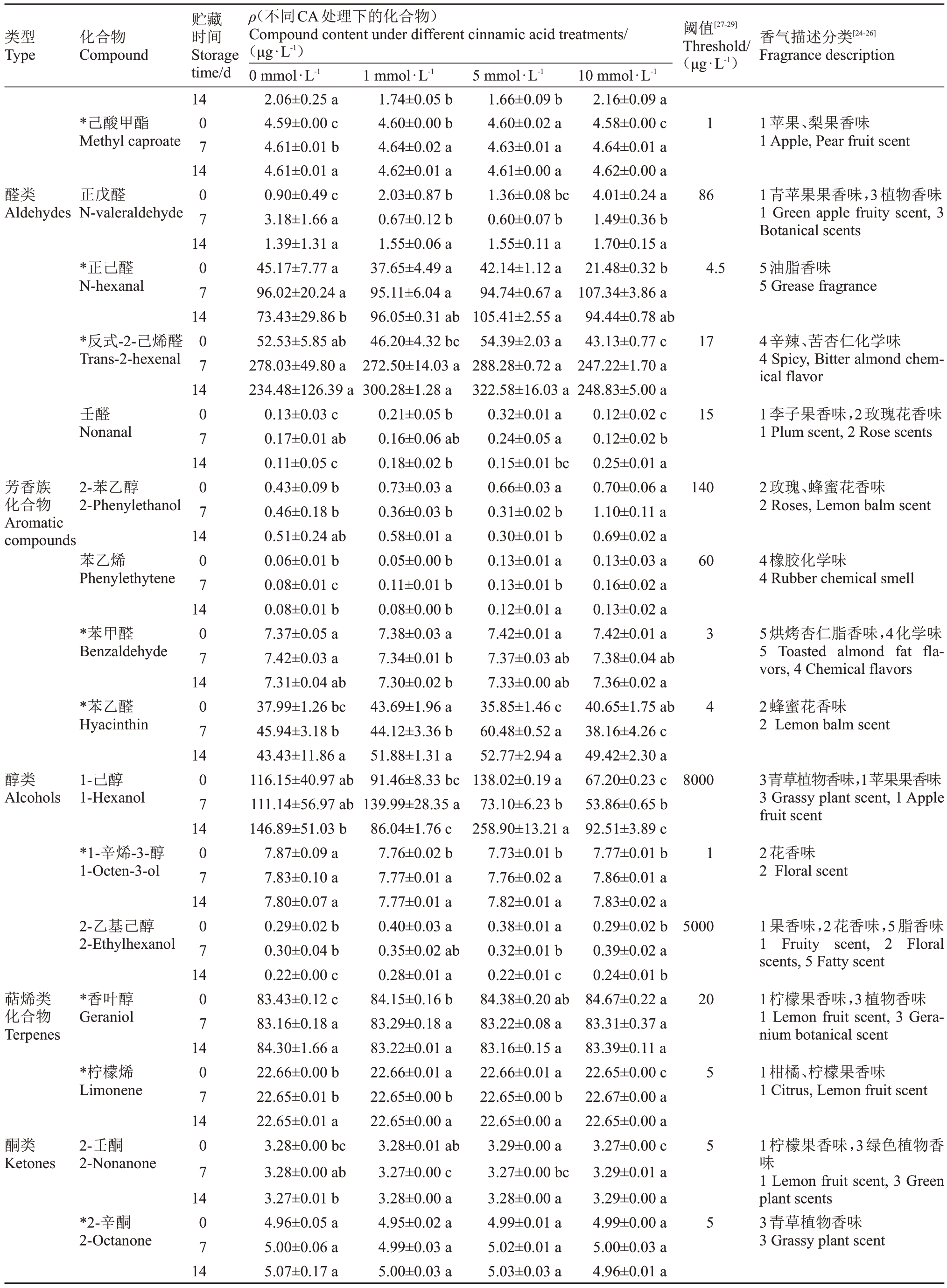
类型Type化合物Compound贮藏时间Storage time/d ρ(不同CA处理下的化合物)Compound content under different cinnamic acid treatments/(μg·L-1)0 mmol·L-11 mmol·L-15 mmol·L-110 mmol·L-1香气描述分类[24-26]Fragrance description阈值[27-29]Threshold/(μg·L-1)14*己酸甲酯Methyl caproate 0 7 1 1苹果、梨果香味1 Apple,Pear fruit scent 14醛类Aldehydes正戊醛N-valeraldehyde 0 7 86 14 1青苹果果香味,3植物香味1 Green apple fruity scent, 3 Botanical scents*正己醛N-hexanal 0 7 4.5 5油脂香味5 Grease fragrance 14*反式-2-己烯醛Trans-2-hexenal 0 7 17 14 4辛辣、苦杏仁化学味4 Spicy,Bitter almond chemical flavor壬醛Nonanal 0 7 15 1李子果香味,2玫瑰花香味1 Plum scent,2 Rose scents 14芳香族化合物Aromatic compounds 2-苯乙醇2-Phenylethanol 0 7 140 2玫瑰、蜂蜜花香味2 Roses,Lemon balm scent 14苯乙烯Phenylethytene 0 7 60 4橡胶化学味4 Rubber chemical smell 14*苯甲醛Benzaldehyde 0 7 14 5烘烤杏仁脂香味,4化学味5 Toasted almond fat flavors,4 Chemical flavors*苯乙醛Hyacinthin 0 7 3 4 2蜂蜜花香味2 Lemon balm scent 14醇类Alcohols 1-己醇1-Hexanol 0 7 8000 14 3青草植物香味,1苹果果香味3 Grassy plant scent,1 Apple fruit scent*1-辛烯-3-醇1-Octen-3-ol 0 7 1 2花香味2 Floral scent 14 2-乙基己醇2-Ethylhexanol 0 7 5000 14 1果香味,2花香味,5脂香味1 Fruity scent, 2 Floral scents,5 Fatty scent萜烯类化合物Terpenes*香叶醇Geraniol 0 7 20 14 1柠檬果香味,3植物香味1 Lemon fruit scent, 3 Geranium botanical scent*柠檬烯Limonene 0 7 1柑橘、柠檬果香味1 Citrus,Lemon fruit scent 14酮类Ketones 2-壬酮2-Nonanone 0 7 14*2-辛酮2-Octanone 0 7 5 5 5 1柠檬果香味,3绿色植物香味1 Lemon fruit scent, 3 Green plant scents 3青草植物香味3 Grassy plant scent 14 2.06±0.25 a 4.59±0.00 c 4.61±0.01 b 4.61±0.01 a 0.90±0.49 c 3.18±1.66 a 1.39±1.31 a 45.17±7.77 a 96.02±20.24 a 73.43±29.86 b 52.53±5.85 ab 278.03±49.80 a 234.48±126.39 a 0.13±0.03 c 0.17±0.01 ab 0.11±0.05 c 0.43±0.09 b 0.46±0.18 b 0.51±0.24 ab 0.06±0.01 b 0.08±0.01 c 0.08±0.01 b 7.37±0.05 a 7.42±0.03 a 7.31±0.04 ab 37.99±1.26 bc 45.94±3.18 b 43.43±11.86 a 116.15±40.97 ab 111.14±56.97 ab 146.89±51.03 b 7.87±0.09 a 7.83±0.10 a 7.80±0.07 a 0.29±0.02 b 0.30±0.04 b 0.22±0.00 c 83.43±0.12 c 83.16±0.18 a 84.30±1.66 a 22.66±0.00 b 22.65±0.01 b 22.65±0.01 a 3.28±0.00 bc 3.28±0.00 ab 3.27±0.01 b 4.96±0.05 a 5.00±0.06 a 5.07±0.17 a 1.74±0.05 b 4.60±0.00 b 4.64±0.02 a 4.62±0.01 a 2.03±0.87 b 0.67±0.12 b 1.55±0.06 a 37.65±4.49 a 95.11±6.04 a 96.05±0.31 ab 46.20±4.32 bc 272.50±14.03 a 300.28±1.28 a 0.21±0.05 b 0.16±0.06 ab 0.18±0.02 b 0.73±0.03 a 0.36±0.03 b 0.58±0.01 a 0.05±0.00 b 0.11±0.01 b 0.08±0.00 b 7.38±0.03 a 7.34±0.01 b 7.30±0.02 b 43.69±1.96 a 44.12±3.36 b 51.88±1.31 a 91.46±8.33 bc 139.99±28.35 a 86.04±1.76 c 7.76±0.02 b 7.77±0.01 a 7.77±0.01 a 0.40±0.03 a 0.35±0.02 ab 0.28±0.01 a 84.15±0.16 b 83.29±0.18 a 83.22±0.01 a 22.66±0.01 a 22.65±0.00 b 22.65±0.00 a 3.28±0.01 ab 3.27±0.00 c 3.28±0.00 a 4.95±0.02 a 4.99±0.03 a 5.00±0.03 a 1.66±0.09 b 4.60±0.02 a 4.63±0.01 a 4.61±0.00 a 1.36±0.08 bc 0.60±0.07 b 1.55±0.11 a 42.14±1.12 a 94.74±0.67 a 105.41±2.55 a 54.39±2.03 a 288.28±0.72 a 322.58±16.03 a 0.32±0.01 a 0.24±0.05 a 0.15±0.01 bc 0.66±0.03 a 0.31±0.02 b 0.30±0.01 b 0.13±0.01 a 0.13±0.01 b 0.12±0.01 a 7.42±0.01 a 7.37±0.03 ab 7.33±0.00 ab 35.85±1.46 c 60.48±0.52 a 52.77±2.94 a 138.02±0.19 a 73.10±6.23 b 258.90±13.21 a 7.73±0.01 b 7.76±0.02 a 7.82±0.01 a 0.38±0.01 a 0.32±0.01 b 0.22±0.01 c 84.38±0.20 ab 83.22±0.08 a 83.16±0.15 a 22.66±0.01 a 22.65±0.00 b 22.65±0.00 a 3.29±0.00 a 3.27±0.00 bc 3.28±0.00 a 4.99±0.01 a 5.02±0.01 a 5.03±0.03 a 2.16±0.09 a 4.58±0.00 c 4.64±0.01 a 4.62±0.00 a 4.01±0.24 a 1.49±0.36 b 1.70±0.15 a 21.48±0.32 b 107.34±3.86 a 94.44±0.78 ab 43.13±0.77 c 247.22±1.70 a 248.83±5.00 a 0.12±0.02 c 0.12±0.02 b 0.25±0.01 a 0.70±0.06 a 1.10±0.11 a 0.69±0.02 a 0.13±0.03 a 0.16±0.02 a 0.13±0.02 a 7.42±0.01 a 7.38±0.04 ab 7.36±0.02 a 40.65±1.75 ab 38.16±4.26 c 49.42±2.30 a 67.20±0.23 c 53.86±0.65 b 92.51±3.89 c 7.77±0.01 b 7.86±0.01 a 7.83±0.02 a 0.29±0.02 b 0.39±0.02 a 0.24±0.01 b 84.67±0.22 a 83.31±0.37 a 83.39±0.11 a 22.65±0.00 c 22.67±0.00 a 22.65±0.00 a 3.27±0.00 c 3.29±0.01 a 3.29±0.00 a 4.99±0.00 a 5.00±0.03 a 4.96±0.01 a
如表2所示,高浓度CA处理在特定贮藏时间对部分化合物生成有促进作用。如贮藏0 d 的丁酸乙酯、丁酸甲酯,7 d 的柠檬烯,10 mmol·L-1 处理的OⅤA 值显著高于其他处理;香叶醇在贮藏0 d,其OⅤA 值随着处理浓度升高而增高。己酸甲酯在贮藏7 d,1、5 和10 mmol·L-1处理的OⅤA 值显著高于0 mmol·L-1处理。
表2 CA 处理对13 种OAV≥1 的香气化合物OVA 值的影响
Table 2 Effects of CA treatments on the OVA values of 13 aroma compounds of OVA value≥1
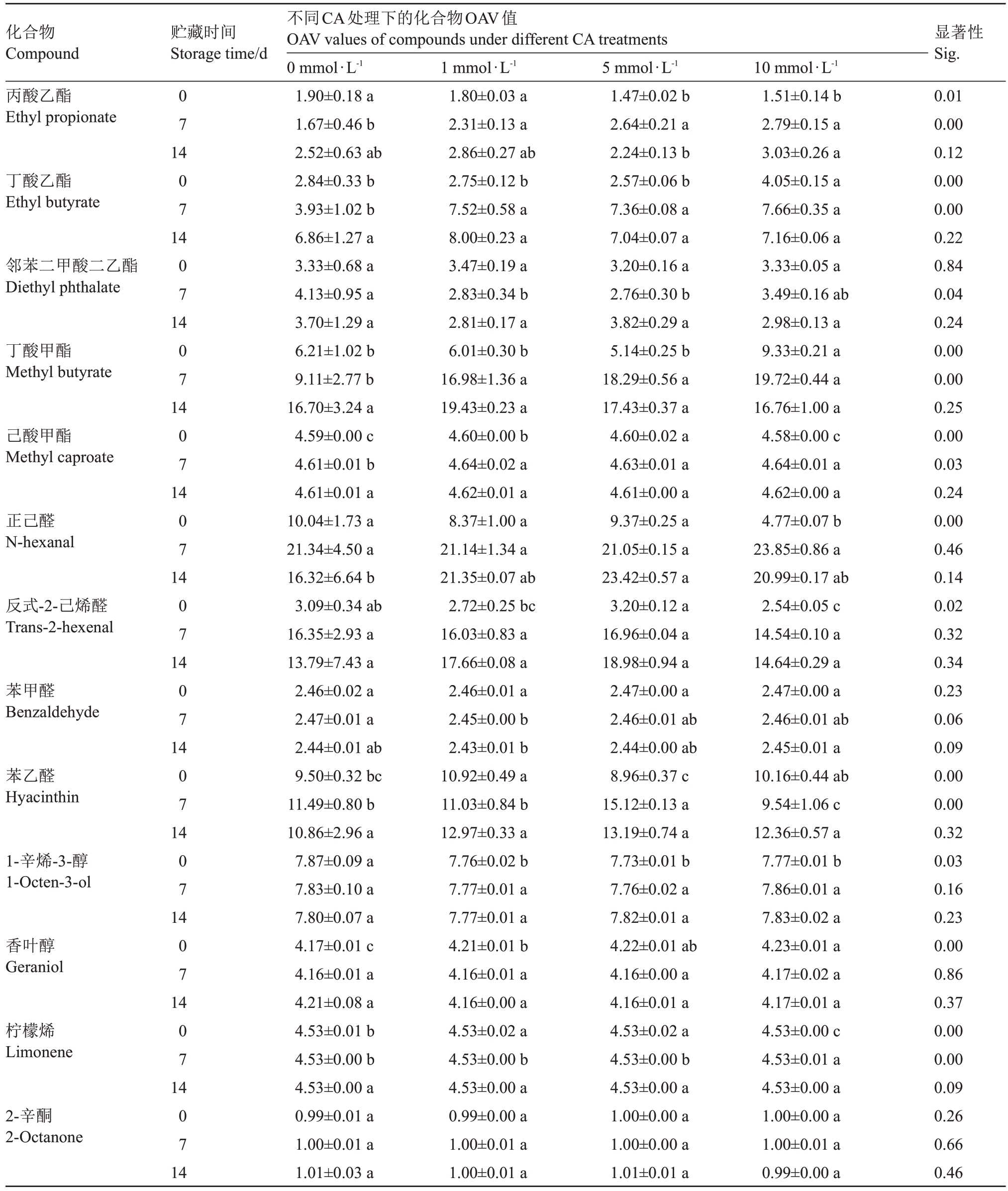
化合物Compound贮藏时间Storage time/d显著性Sig.丙酸乙酯Ethyl propionate 0 7 14丁酸乙酯Ethyl butyrate 0 7 14邻苯二甲酸二乙酯Diethyl phthalate 0 7 14丁酸甲酯Methyl butyrate 0 7 14己酸甲酯Methyl caproate 0 7 14正己醛N-hexanal 0 7 14反式-2-己烯醛Trans-2-hexenal 0 7 14苯甲醛Benzaldehyde 0 7 14苯乙醛Hyacinthin 0 7 14 1-辛烯-3-醇1-Octen-3-ol 0 7 14香叶醇Geraniol 0 7 14柠檬烯Limonene 0 7 14 2-辛酮2-Octanone 0 7 14不同CA处理下的化合物OAⅤ值OAⅤvalues of compounds under different CA treatments 0 mmol·L-1 1.90±0.18 a 1.67±0.46 b 2.52±0.63 ab 2.84±0.33 b 3.93±1.02 b 6.86±1.27 a 3.33±0.68 a 4.13±0.95 a 3.70±1.29 a 6.21±1.02 b 9.11±2.77 b 16.70±3.24 a 4.59±0.00 c 4.61±0.01 b 4.61±0.01 a 10.04±1.73 a 21.34±4.50 a 16.32±6.64 b 3.09±0.34 ab 16.35±2.93 a 13.79±7.43 a 2.46±0.02 a 2.47±0.01 a 2.44±0.01 ab 9.50±0.32 bc 11.49±0.80 b 10.86±2.96 a 7.87±0.09 a 7.83±0.10 a 7.80±0.07 a 4.17±0.01 c 4.16±0.01 a 4.21±0.08 a 4.53±0.01 b 4.53±0.00 b 4.53±0.00 a 0.99±0.01 a 1.00±0.01 a 1.01±0.03 a 1 mmol·L-1 1.80±0.03 a 2.31±0.13 a 2.86±0.27 ab 2.75±0.12 b 7.52±0.58 a 8.00±0.23 a 3.47±0.19 a 2.83±0.34 b 2.81±0.17 a 6.01±0.30 b 16.98±1.36 a 19.43±0.23 a 4.60±0.00 b 4.64±0.02 a 4.62±0.01 a 8.37±1.00 a 21.14±1.34 a 21.35±0.07 ab 2.72±0.25 bc 16.03±0.83 a 17.66±0.08 a 2.46±0.01 a 2.45±0.00 b 2.43±0.01 b 10.92±0.49 a 11.03±0.84 b 12.97±0.33 a 7.76±0.02 b 7.77±0.01 a 7.77±0.01 a 4.21±0.01 b 4.16±0.01 a 4.16±0.00 a 4.53±0.02 a 4.53±0.00 b 4.53±0.00 a 0.99±0.00 a 1.00±0.01 a 1.00±0.01 a 5 mmol·L-1 1.47±0.02 b 2.64±0.21 a 2.24±0.13 b 2.57±0.06 b 7.36±0.08 a 7.04±0.07 a 3.20±0.16 a 2.76±0.30 b 3.82±0.29 a 5.14±0.25 b 18.29±0.56 a 17.43±0.37 a 4.60±0.02 a 4.63±0.01 a 4.61±0.00 a 9.37±0.25 a 21.05±0.15 a 23.42±0.57 a 3.20±0.12 a 16.96±0.04 a 18.98±0.94 a 2.47±0.00 a 2.46±0.01 ab 2.44±0.00 ab 8.96±0.37 c 15.12±0.13 a 13.19±0.74 a 7.73±0.01 b 7.76±0.02 a 7.82±0.01 a 4.22±0.01 ab 4.16±0.00 a 4.16±0.01 a 4.53±0.02 a 4.53±0.00 b 4.53±0.00 a 1.00±0.00 a 1.00±0.00 a 1.01±0.01 a 10 mmol·L-1 1.51±0.14 b 2.79±0.15 a 3.03±0.26 a 4.05±0.15 a 7.66±0.35 a 7.16±0.06 a 3.33±0.05 a 3.49±0.16 ab 2.98±0.13 a 9.33±0.21 a 19.72±0.44 a 16.76±1.00 a 4.58±0.00 c 4.64±0.01 a 4.62±0.00 a 4.77±0.07 b 23.85±0.86 a 20.99±0.17 ab 2.54±0.05 c 14.54±0.10 a 14.64±0.29 a 2.47±0.00 a 2.46±0.01 ab 2.45±0.01 a 10.16±0.44 ab 9.54±1.06 c 12.36±0.57 a 7.77±0.01 b 7.86±0.01 a 7.83±0.02 a 4.23±0.01 a 4.17±0.02 a 4.17±0.01 a 4.53±0.00 c 4.53±0.01 a 4.53±0.00 a 1.00±0.00 a 1.00±0.01 a 0.99±0.00 a 0.01 0.00 0.12 0.00 0.00 0.22 0.84 0.04 0.24 0.00 0.00 0.25 0.00 0.03 0.24 0.00 0.46 0.14 0.02 0.32 0.34 0.23 0.06 0.09 0.00 0.00 0.32 0.03 0.16 0.23 0.00 0.86 0.37 0.00 0.00 0.09 0.26 0.66 0.46
高浓度或低浓度CA处理会抑制部分香气化合物生成。贮藏0 d,5和10 mmol·L-1处理的丙酸乙酯OⅤA 值显著低于0 和1 mmol·L-1处理;10 mmol·L-1处理的正己醛OⅤA值在贮藏0 d时显著低于其他处理;1-辛烯-3-醇在贮藏0 d,0 mmol·L-1处理的OⅤA值显著高于其他处理,即无CA 处理时更利于其生成。贮藏7 d,1 和5 mmol·L-1处理的邻苯二甲酸二乙酯、1 mmol·L-1处理的苯甲醛OⅤA 值均显著低于0 mmol·L-1处理。
不同浓度CA 处理在不同贮藏时间对一些化合物的影响复杂。苯乙醛在贮藏0 d,1 mmol·L-1处理的OⅤA 值最高,5 mmol·L-1 处理最低;7 d 则是5 mmol·L-1处理的OⅤA 值显著高于其他处理,10 mmol·L-1处理降低。反式-2-己烯醛在贮藏0 d,5 mmol·L-1处理的OⅤA值最高,10 mmol·L-1处理的最低,二者呈显著差异。
2.2 CA处理对巨峰葡萄不同类型香气化合物含量的影响
巨峰葡萄贮藏期不同类型香气化合物含量如图1所示。0 d时,酯类、醛类、芳香族化合物、醇类和萜烯类化合物含量各自在处理间均存在显著差异,其中酯类在5 mmol·L-1处理时含量最低,显著低于对照,10 mmol·L-1处理显著高于对照;醇类在5 mmol·L-1处理时含量最高,与对照差异不显著,但显著高于10 mmol·L-1处理;醛类在10 mmol·L-1处理时显著低于对照;萜烯类化合物含量在10 mmol·L-1处理时最高,显著高于对照;芳香族化合物含量在5 mmol·L-1处理时最低,与对照差异不显著,在1 mmol·L-1处理时显著高于对照。7 d时,酯类、醇类和芳香族化合物含量处理间差异显著,其中酯类含量在10 mmol·L-1处理时最高,显著高于对照46.84%,芳香族化合物含量在5 mmol·L-1处理时最高,在10 mmol·L-1处理时最低,二者均与对照呈显著差异;醇类含量在1 mmol·L-1处理时最高,在10 mmol·L-1处理时最低。14 d 时,仅醇类含量处理间差异显著,其中5 mmol·L-1处理含量最高,显著高于对照72.31%。
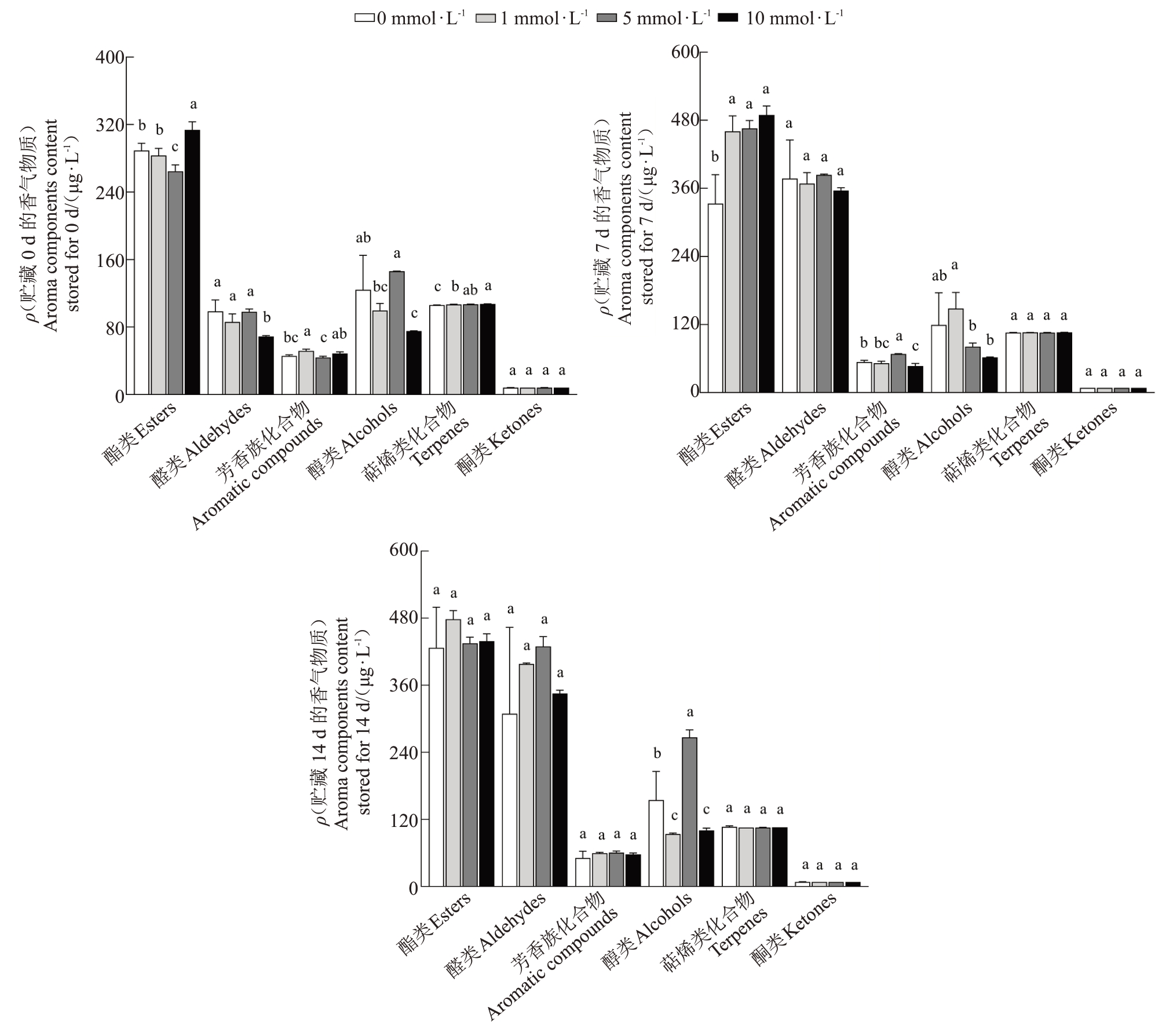
图1 CA 处理对不同类型化合物含量的影响
Fig.1 Effects of cinnamic acid treatments on the contents of different types of compounds
不同小写字母表示处理间存在显著差异(p<0.05)。下同。
Different small letters indicate significant difference between treatments(p<0.05).The same below.
CA 处理后,在贮藏期内,酯类和醛类是葡萄中最主要的香气成分,它们的含量总体呈先上升后下降的变化趋势。酯类含量在10 mmol·L-1处理下均有增加,而醛类含量在贮藏初期受10 mmol·L-1处理抑制效果显著。芳香族化合物含量在贮藏0 d和7 d时处理间差异显著,但处理效果有波动。醇类含量在所有贮藏时间点上处理间均存在显著差异,贮藏初期和后期5 mmol·L-1处理下含量最高,贮藏中期时1 mmol·L-1处理下含量最高,但中高浓度处理有显著的抑制效果。萜烯类化合物含量仅在贮藏初期1 和10 mmol·L-1处理显著高于对照,酮类含量在所有处理中相对稳定,且酮类含量最低。综上,在贮藏初期,CA处理对酯类、醛类、醇类、萜烯类和芳香族化合物含量有显著影响,但影响随贮藏时间延长而减弱。
2.3 CA处理与不同类型香气化合物含量的相关性分析
对整个贮藏时期CA处理与不同香气类型的化合物含量进行相关性分析(图2)。0 d时,CA处理与醛类含量呈显著负相关,与萜烯类含量呈极显著正相关;酯类含量与醛类含量呈显著负相关,与醇类含量呈极显著负相关;醛类含量与醇类含量呈极显著正相关,芳香族化合物含量与醇类含量呈显著负相关。7 d时,CA处理与酯类含量呈显著正相关,与醇类含量呈显著负相关。14 d时,CA处理与六类化合物含量相关性不显著,酯类含量与萜烯类化合物含量呈极显著负相关;醛类含量与芳香族化合物含量呈极显著正相关,与酮类含量呈极显著负相关;芳香族化合物含量与酮类含量呈显著负相关。总之,CA处理与酯类含量、萜烯类含量呈正相关,与醛类含量、醇类含量呈负相关,相关性随贮藏时间延长而减弱。
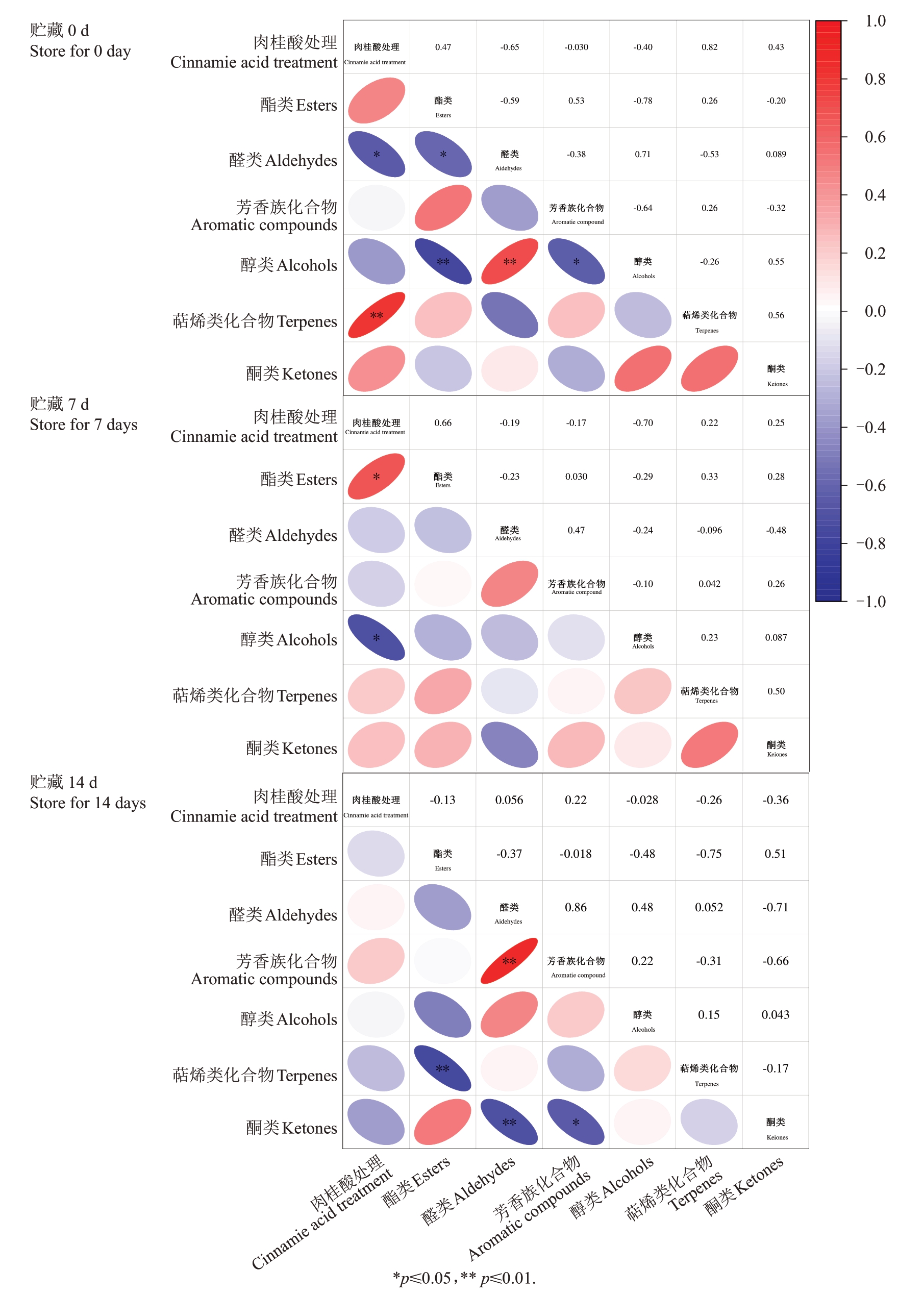
图2 CA 处理与不同类型化合物的相关性分析
Fig.2 Correlation analysis of cinnamic acid treatments with different types of compounds
2.4 香气雷达图分析
分析不同CA处理的巨峰葡萄在整个贮藏期的香气雷达图(图3),发现果实香气有果香味、花香味、植物味、脂香味和化学味。在贮藏0 d时,气味强度表现为果香味>花香味>脂香味>植物味>化学味。果香味OAⅤ在10 mmol·L-1处理最大(比CK高13.65%),花香味OAⅤ在1 mmol·L-1处理最大(比CK高7.09%);化学味和脂香味OAⅤ在10 mmol·L-1处理最小(分别比CK低9.65%、41.86%)。7 d时,气味强度表现为果香味>脂香味>花香味>化学味>植物味。果香味OAⅤ在10 mmol·L-1处理最大(比CK高44.73%);花香味OAⅤ在5 mmol·L-1处理最大(比CK 高9.40%),10 mmol·L-1处理最小(比CK 低10.85%);化学味OAⅤ在5 mmol·L-1最大(比CK 高3.12%),10 mmol·L-1处理最小(比CK低9.68%);脂香味OAⅤ在10 mmol·L-1 处理最大(比CK 高10.56%)。14 d时(除0 mmol·L-1),气味强度表现为果香味>脂香味>花香味>化学味>植物味。果香味OAⅤ在1 mmol·L-1处理最大(比CK高8.65%);花香味OAⅤ在5 mmol·L-1处理最大(比CK高11.07%);化学味和脂香味OAⅤ在5 mmol·L-1处理最大(分别比CK 高31.99%、37.88%)。总体而言,随着贮藏时间延长,葡萄香气雷达图向脂香味和化学味偏移,但果香味主导,CA处理可增强整个贮藏期的果香味。
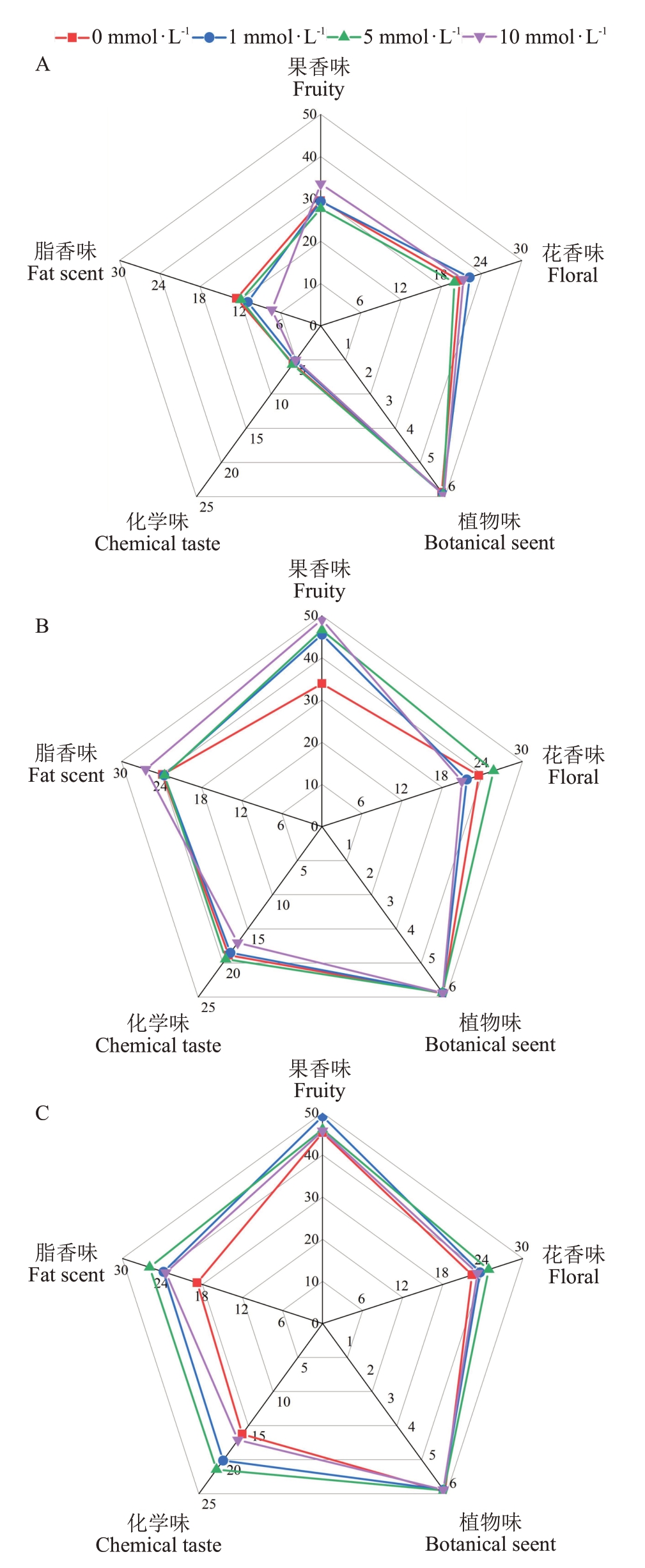
图3 不同CA 处理的香气雷达图分析
Fig.3 Aroma profile analysis of different cinnamic acid treatments
A.贮藏0 d;B.贮藏7 d;C.贮藏14 d。
A.Store for 0 day;B.Store for 7 days;C.Store for 14 days.
2.5 熵权topsis评价
熵权TOPSIS方法是一种结合了熵权法和TOPSIS(technique for order preference by similarity to ideal solution,接近理想解排序法)的多属性决策分析方法,这种方法能够综合考虑指标的客观重要性和评价对象的相对位置,从而提供一个更为全面和客观的决策支持工具。
对于成熟水果的香气雷达图,人们通常倾向于更丰富的果香味、花香味和脂香味,太浓的植物味可能意味着成熟度过低,化学味也通常评价为负面,据此结合香气雷达图分析,对3个贮藏时期的香味类型的OⅤA值进行熵权TOPSIS评价,如表3所示,10 mmol·L-1 CA处理排名第一,其次是1和5 mmol·L-1 CA处理,表明4种处理中,10 mmol·L-1 CA处理效果最好。
表3 TOPSIS 评价计算结果
Table 3 TOPSIS evaluation calculations
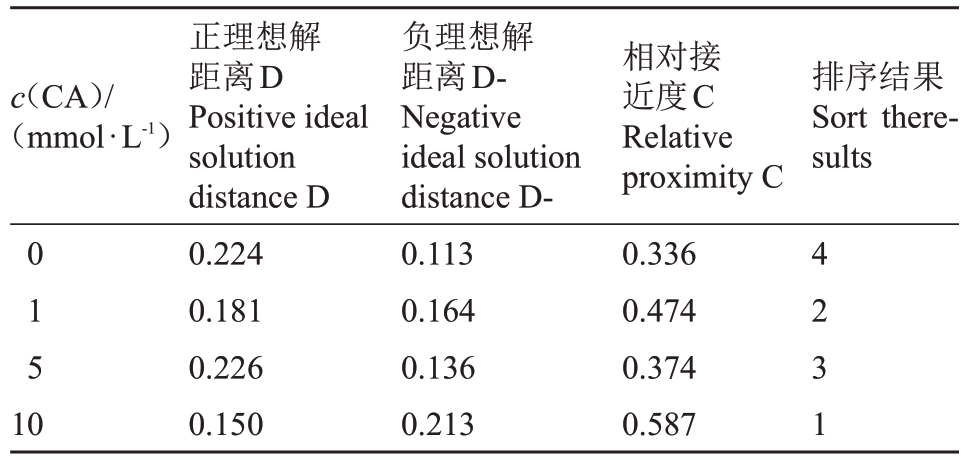
c(CA)/(mmol·L-1)排序结果Sort theresults 0 1 5 10正理想解距离D Positive ideal solution distance D 0.224 0.181 0.226 0.150负理想解距离DNegative ideal solution distance D-0.113 0.164 0.136 0.213相对接近度C Relative proximity C 0.336 0.474 0.374 0.587 4 2 3 1
3 讨 论
本试验结果表明,巨峰葡萄果实中共检测出32 种香气化合物(酯类17 种、醛类4 种、芳香族化合物4 种、醇类3 种、萜烯类2 种、酮类2 种),对定性定量结果进行方差分析,结果显示,巨峰葡萄果实香气由13种呈香成分贡献,这些成分中有11种香气化合物(酯类5种、醛类2种、萜烯类2种、芳香族化合物1种、醇类1种)受CA处理的影响存在显著差异;CA处理主要影响福建福安产区巨峰葡萄果实香气中的酯类、醛类、萜烯类、芳香族化合物和醇类。李金金等[30]研究表明,随着贮藏时间的延长不同处理组葡萄果实中醛类物质相对含量总体呈先上升后下降的变化趋势,与本研究的趋势相同。此外,SO2作为常见的果实保鲜剂,随着处理时间的延长,葡萄中酯类物质含量逐渐下降,醇类物质含量逐渐增加[31],本研究中CA的处理效应与之相反,尤其是10 mmol·L-1处理更大程度保持了巨峰葡萄的特征呈香成分。
巨峰葡萄的香气物质合成途径主要涉及4 个关键代谢路径:脂肪酸代谢、氨基酸代谢、异戊二烯代谢以及类胡萝卜素代谢。在脂肪酸代谢途径中,脂肪酸在酶的催化下逐步降解为小分子的乙酰辅酶A。随后,通过一系列酶促反应,这些小分子转化为多种醇类、酮类和酯类香气物质[20,32]。在氨基酸代谢途径中,半胱氨酸、苯丙氨酸等氨基酸扮演着重要角色。它们通过莽草酸途径和苯丙烷途径参与合成芳香族化合物[32-33]。异戊二烯代谢途径,包括甲羟戊酸(MⅤA)途径和二磷酸甲羟戊酸(MEⅤ)途径,是萜类化合物合成的关键。这两个途径共同作用,生成IPP(异戊烯焦磷酸)和DMAPP(二甲基烯丙基焦磷酸),这两种化合物是构建萜类物质的基本单元[34-35]。类胡萝卜素代谢途径不仅在植物光合作用中扮演重要角色,也是某些香气物质的前体。类胡萝卜素通过氧化裂解过程,可以转化为一系列含氧衍生物,例如β-大马酮、橙花醇和香叶醇等[32]。CA作为一种芳香族的酚酸类化合物,主要在植物苯丙烷代谢途径合成,而苯丙烷代谢途径的多种次生代谢产物是香气物质的合成前体[36-38],本试验中CA 处理可以影响OAⅤ≥1 的5 种酯类、2 种醛类、2 种萜烯类、1 种芳香族化合物、1 种醇类共11 种香气化合物的含量,表明CA可能通过影响葡萄的脂肪酸代谢、氨基酸代谢、异戊二烯代谢以及类胡萝卜素代谢途径,间接或直接影响香气物质的合成。具体影响这些代谢途径的哪部分通路,还有待后续研究。
本试验中高浓度的CA处理均能提高葡萄中酯类物质的含量,在各时期均高于CK。尤其是贮藏7 d时,CA 处理的葡萄中酯类化合物含量均显著高于对照组,且随CA浓度的增加而增加,丙酸乙酯最符合此阶段变化趋势,可能是脂肪酸代谢途径中醇酰基转移酶(AMAT)参与了成熟果实丙酸乙酯的合成[39]。此外,在苯丙烷途径中,肉桂酸-4-羟化酶(C4H)能够将CA 对位羟化为对香豆酸,这一步骤对后续的酯类和萜烯类合成至关重要[40],本试验中CA 处理在贮藏初期提高了萜烯类物质的含量。4-香豆酸-辅酶A 连接酶(4CL)是苯丙酸途径的最后一个酶,它催化对香豆酸和其他含羟基或甲氧基苯乙烯酸的衍生物与辅酶A形成相应的酯,这些酯类物质是苯丙烷代谢途径的关键中间产物[41]。
对CA处理与不同类型香气化合物的方差分析和相关性分析的结果显示,在贮藏0 d 时,高浓度CA 处理对酯类、醇类、醛类、萜烯类和芳香族化合物的影响达显著水平,CA 处理与醛类化合物含量呈显著负相关,与萜烯类化合物含量呈显著正相关;贮藏7 d 时,CA 处理对酯类和醇类的影响达显著水平,CA 处理与酯类化合物含量呈显著正相关,与醇类含量呈显著负相关;贮藏14 d 时,仅醇类化合物处理间差异显著,CA 处理与六类化合物之间的相关性均不显著,这表明高浓度的CA 处理可以提高葡萄果实中的酯类和萜烯类化合物含量,降低醛类和醇类化合物含量。不同贮藏时间的葡萄果实香气雷达图分析和熵权TOPSIS 评价结果显示,4 种处理中,10 mmol·L-1 CA 处理效果最好,可以有效提高葡萄的果香味、花香味和脂香味。
4 结 论
采前10 d 喷施CA,处理后的巨峰葡萄果实香气主要由酯类、醛类和芳香族化合物等组成,处理提高了酯类化合物的含量,让葡萄果香味、花香味和脂香味更加浓郁,同时降低了刺激性的化学味,这对提升葡萄果实品质具有重要作用。通过综合评价,10 mmol·L-1 CA 处理效果最佳,具备在鲜食葡萄栽培生产中应用的潜力。
[1] 姜建福.葡萄果肉质地性状的评价、QTL 定位及候选基因预测[D].杨凌:西北农林科技大学,2020.JIANG Jianfu.Evaluation,QTL analysis and candidate gene prediction for berry texture in Vitis vinifera L.[D].Yangling:Northwest A&F University,2020.
[2] ALEM H,RIGOU P,SCHNEIDER R,OJEDA H,TORREGROSA L. Impact of agronomic practices on grape aroma composition:A review[J]. Journal of the Science of Food and Agriculture,2019,99(3):975-985.
[3] LI Y Z,HE L L,SONG Y H,ZHANG P,CHEN D D,GUAN L P,LIU S J. Comprehensive study of volatile compounds and transcriptome data providing genes for grape aroma[J]. BMC Plant Biology,2023,23(1):171.
[4] 姜有虎,李彦彪,常永平,李旭林.嘉峪关地区‘霞多丽’葡萄的采收期[J].林业科技通讯,2022(4):72-75.JIANG Youhu,LI Yanbiao,CHANG Yongping,LI Xulin.Harvesting period of Vitis vinifrea‘Chardonnay’in Jiayuguan area[J].Forest Science and Technology,2022(4):72-75.
[5] 马宗桓,李彦彪,赵津,李文芳,毛娟,陈佰鸿.不同肥料配比对荒漠区‘黑比诺’葡萄果实品质的影响[J].北方园艺,2022(4):1-7.MA Zonghuan,LI Yanbiao,ZHAO Jin,LI Wenfang,MAO Juan,CHEN Baihong. Effects of different fertilizer ratios on fruit quality of‘Pinot Noir’grape in desert areas[J]. Northern Horticulture,2022(4):1-7.
[6] 张亚光,白耀栋.不同架式对酿酒葡萄产量与果实品质的影响[J].西北园艺,2022(2):41-43.ZHANG Yaguang,BAI Yaodong. Effect of different rack sizes on wine grape yield and fruit quality[J].Northwest Horticulture,2022(2):41-43.
[7] 金欢淳,金联宇,陈亦雅,王良德,吴颖,胡丹,张培安.不同栽培措施对改善妮娜皇后葡萄果实着色与品质的效果[J].果树学报,2024,41(10):2051-2066.JIN Huanchun,JIN Lianyu,CHEN Yiya,WANG Liangde,WU Ying,HU Dan,ZHANG Peian. Different cultivation practices promote berry coloration and quality in Queen Nina grape[J].Journal of Fruit Science,2024,41(10):2051-2066.
[8] 张文文,吴玉森,陈毓谨,郑奇志,马超,许文平,张才喜,王世平.3 种巨峰系葡萄的香气特征[J].上海交通大学学报(农业科学版),2018,36(5):51-59.ZHANG Wenwen,WU Yusen,CHEN Yujin,ZHENG Qizhi,MA Chao,XU Wenping,ZHANG Caixi,WANG Shiping.Aroma characteristics of three Kyoho grapevine series[J].Journal of Shanghai Jiao Tong University (Agricultural Science),2018,36(5):51-59.
[9] 张乐,张亚红,乔振羽,王亚楠,陈璐,周娟,黄嘉俊.不同昼夜温差对赤霞珠葡萄果实香气的影响及转录组分析[J].核农学报,2023,37(4):865-878.ZHANG Le,ZHANG Yahong,QIAO Zhenyu,WANG Yanan,CHEN Lu,ZHOU Juan,HUANG Jiajun.Effect of diurnal amplitude on fruit aroma of cabernet sauvignon and transcriptome analysis[J]. Journal of Nuclear Agricultural Sciences,2023,37(4):865-878.
[10] DONG T Y,HAO T Y,HAKEEM A,REN Y H,FANG J G.Synergistic variation in abscisic acid and brassinolide treatment signaling component alleviates fruit quality of‘Shine Muscat’grape during cold storage[J]. Food Chemistry,2025,464:141584.
[11] TOBARUELA E C,GOMES B L,BONATO ⅤC B,DE LIMA E S,FRESCHI L,PURGATTO E.Ethylene and auxin:Hormonal regulation of volatile compound production during tomato(Solanum lycopersicum L.) fruit ripening[J]. Frontiers in Plant Science,2021,12:765897.
[12] LI W,YE N,XIE P,ZHANG Z.Regulatory mechanism of methyl jasmonate and methyl dihydrojasmonate in enhancing aroma in‘Cabernet Gernischt’via the lipoxygenase pathway[J]. Journal of the Science of Food and Agriculture,2025,105(2):807-815.
[13] 李晓颖,谭洪花,房经贵,韩键,宋长年.果树果实的风味物质及其研究[J].植物生理学报,2011,47(10):943-950.LI Xiaoying,TAN Honghua,FANG Jinggui,HAN Jian,SONG Changnian. Flavor compounds in fruits and research on them[J].Plant Physiology Journal,2011,47(10):943-950.
[14] 胡玉龙,田淑芬,王超霞,王荣,马闯.采前肉桂酸处理对‘巨峰’葡萄耐贮性的影响[J].中外葡萄与葡萄酒,2024(4):26-31.HU Yulong,TIAN Shufen,WANG Chaoxia,WANG Rong,MA Chuang. Effects of preharvest cinnamic acid treatment on storability of‘Kyoho’grapes[J].Sino-Overseas Grapevine&Wine,2024(4):26-31.
[15] 成明,黄艳凤,张平,朱志强,李志文,任朝晖.SO2伤害对巨峰葡萄香气物质的影响研究[J].食品工业科技,2011,32(6):350-353.CHENG Ming,HUANG Yanfeng,ZHANG Ping,ZHU Zhiqiang,LI Zhiwen,REN Zhaohui.Study on effects of SO2 injury on aroma compounds in Kyoho grapes[J]. Science and Technology of Food Industry,2011,32(6):350-353.
[16] 冀晓昊,刘凤之,史祥宾,王宝亮,刘培培,王海波.架式和新梢间距对‘巨峰’葡萄果实品质的影响[J].中国农业科学,2019,52(7):1164-1172.JI Xiaohao,LIU Fengzhi,SHI Xiangbin,WANG Baoliang,LIU Peipei,WANG Haibo. The effects of different training systems and shoot spacing on the fruit quality of‘Kyoho’grape[J]. Scientia Agricultura Sinica,2019,52(7):1164-1172.
[17] 王海波,张克坤,冀晓昊,王孝娣,史祥宾,王宝亮,郑晓翠,刘凤之. 不同颜色果袋对‘巨峰’葡萄果实中挥发性成分的影响[J].应用生态学报,2017,28(4):1274-1280.WANG Haibo,ZHANG Kekun,JI Xiaohao,WANG Xiaodi,SHI Xiangbin,WANG Baoliang,ZHENG Xiaocui,LIU Fengzhi.Effects of different color paper bags on volatile constituents of Kyoho grape berries[J].Chinese Journal of Applied Ecology,2017,28(4):1274-1280.
[18] 权桂蓉,高翔,惠竹梅.外源激素处理对葡萄及葡萄酒香气成分的影响[J].西北农林科技大学学报(自然科学版),2020,48(1):126-134.QUAN Guirong,GAO Xiang,XI Zhumei. Effect of exogenous plant hormones on aroma components of grapes and dry red wine[J]. Journal of Northwest A & F University (Natural Science Edition),2020,48(1):126-134.
[19] 刘鑫铭,陈婷,刘锡铭,雷龑.含氨基酸水溶性肥料对巨峰葡萄的影响[J].福建农业学报,2019,34(7):782-789.LIU Xinming,CHEN Ting,LIU Ximing,LEI Yan. Effects of spraying water- soluble,amino acids- containing fertilizer on Kyoho grape vines[J]. Fujian Journal of Agricultural Sciences,2019,34(7):782-789.
[20] 袁园园,马盼,门洪文,黄翊鹏,郭守鹏,姚玉新.巨峰葡萄成熟过程中挥发性香气物质的变化[J].山东农业大学学报(自然科学版),2015,46(6):812-816.YUAN Yuanyuan,MA Pan,MEN Hongwen,HUANG Yipeng,GUO Shoupeng,YAO Yuxin.Changes of aroma volatiles during berry ripening of Kyoho grape[J]. Journal of Shandong Agricultural University (Natural Science Edition),2015,46(6):812-816.
[21] 及华,关军锋,冯云霄,李丽梅,孙玉龙.温度和包装对巨峰葡萄贮藏品质的影响[J].食品与发酵工业,2006,32(1):138-140.JI Hua,GUAN Junfeng,FENG Yunxiao,LI Limei,SUN Yulong. Effect of temperature and package on storage quality of Kyoho grapes[J]. Food and Fermentation Industries,2006,32(1):138-140.
[22] 康慧芳,乔勇进,王晓,刘晨霞,张怡,陈冰洁.不同保鲜剂处理对“巨峰”葡萄货架期品质的影响[J].保鲜与加工,2020,20(6):6-13.KANG Huifang,QIAO Yongjin,WANG Xiao,LIU Chenxia,ZHANG Yi,CHEN Bingjie. Effects of different preservatives treatment on shelf-life quality of‘Jufeng’grape[J].Storage and Process,2020,20(6):6-13.
[23] 李凯,商佳胤,苏宏,田淑芬,黄建全,张娜,王丹,王超霞.顶空固相微萃取-气相色谱质谱法分析红富士葡萄果实香气[J].福建农业学报,2021,36(4):426-432.LI Kai,SHANG Jiayin,SU Hong,TIAN Shufen,HUANG Jianquan,ZHANG Na,WANG Dan,WANG Chaoxia. Composition and characteristics of Benifuji grape aroma[J]. Fujian Journal of Agricultural Sciences,2021,36(4):426-432.
[24] 尹鹏,卫艺炜,王静,王晓,张向娜,苏丹,王晶晶,孙慕芳,郭桂义,刘仲华.清香型信阳毛尖茶关键呈香成分鉴定[J].食品科学,2024,45(21):222-228.YIN Peng,WEI Yiwei,WANG Jing,WANG Xiao,ZHANG Xiangna,SU Dan,WANG Jingjing,SUN Mufang,GUO Guiyi,LIU Zhonghua. Identification of the key odorants in clean aroma-type Xinyang Maojian green tea[J]. Food Science,2024,45(21):222-228.
[25] 李安宁,黄张君,向玲,白津榕,吴奇霄,余松柏,黄毅娜.粟酒裂殖酵母与酿酒酵母混合发酵对柚子果酒品质及风味的影响[J].中国酿造,2024,43(3):40-48.LI Anning,HUANG Zhangjun,XIANG Ling,BAI Jinrong,WU Qixiao,YU Songbai,HUANG Yina. Effects of Schizosaccharomyces pombe and Saccharomyces cerevisiae co-fermentation on the quality and flavor of pomelo wine[J]. China Brewing,2024,43(3):40-48.
[26] 赵晓鑫,葛媛媛,于学健,刘冲,于爽,姚粟.嗜热链球菌和瑞士乳杆菌复配发酵牛乳中挥发性风味物质的研究[J].食品与发酵工业,2024,50(21):301-308.ZHAO Xiaoxin,GE Yuanyuan,YU Xuejian,LIU Chong,YU Shuang,YAO Su. Investigation of volatile flavor compounds in fermented milk with synergistic combination of Streptococcus thermophilus and Lactobacillus helveticus[J]. Food and Fermentation Industries,2024,50(21):301-308.
[27] 罗飞,师旭,王颉,庞永宏,赵彦敏.‘龙眼’葡萄酒微生物变化及与挥发性香气的相关性分析[J]. 中外葡萄与葡萄酒,2023(1):1-7.LUO Fei,SHI Xu,WANG Jie,PANG Yonghong,ZHAO Yanmin.Microbial changes of‘Longan’wine and correlation analysis with volatile aroma[J]. Sino-Overseas Grapevine & Wine,2023(1):1-7.
[28] 李凯,商佳胤,张娜,田淑芬,黄建全,王丹,苏宏,王超霞.HSSPME-GC-MS 分析天津产区‘巨玫瑰’葡萄果实香气成分[J].河北农业大学学报,2021,44(1):67-74.LI Kai,SHANG Jiayin,ZHANG Na,TIAN Shufen,HUANG Jianquan,WANG Dan,SU Hong,WANG Chaoxia. Analysis on aroma components of grape‘Jumeigui’grown in Tianjin by HSSPME-GC-MS[J]. Journal of Hebei Agricultural University,2021,44(1):67-74.
[29] 商浥,陈胜,郝燕,梁艳英,刘延琳.民勤产区自然发酵与接种发酵霞多丽干白葡萄酒香气成分及感官品质的对比分析[J].食品与发酵工业,2025,51(3):317-323.SHANG Yi,CHEN Sheng,HAO Yan,LIANG Yanying,LIU Yanlin. Comparative analysis of aroma components and sensory quality of spontaneous fermentation and inoculated fermentation Chardonnay dry white wine in Minqin region[J]. Food and Fermentation Industries,2025,51(3):317-323.
[30] 李金金,李春媛,谷佰宇,贾晓昱,吴迪,张鹏,李江阔,罗铮.抗菌干预结合微环境气调维持葡萄采后贮藏品质[J].现代食品科技,2024,40(4):121-132.LI Jinjin,LI Chunyuan,GU Baiyu,JIA Xiaoyu,WU Di,ZHANG Peng,LI Jiangkuo,LUO Zheng.Combination of antibacterial intervention and a micro-environmental modified atmosphere for the maintenance of grape storage quality after harvest[J]. Modern Food Science and Technology,2024,40(4):121-132.
[31] 成明.不同贮藏条件对葡萄贮藏期间香气成分变化影响的研究[D].天津:天津科技大学,2011.CHENG Ming. Study on aroma compounds of grape under different storage conditions during storage period[D].Tianjin:Tianjin University of Science&Technology,2011.
[32] 程焕,陈健乐,周晓舟,陈荣荣,刘东红,叶兴乾.水果香气物质分析及合成途径研究进展[J].中国食品学报,2016,16(1):211-218.CHENG Huan,CHEN Jianle,ZHOU Xiaozhou,CHEN Rongrong,LIU Donghong,YE Xingqian. Advances in identification and biosynthetic pathway of key aroma in fruits[J]. Journal of Chinese Institute of Food Science and Technology,2016,16(1):211-218.
[33] 于立志,马永昆,张龙,代春华,于怀龙,李俊芳.GC-O-MS 法检测句容产区巨峰葡萄香气成分分析[J].食品科学,2015,36(8):196-200.YU Lizhi,MA Yongkun,ZHANG Long,DAI Chunhua,YU Huailong,LI Junfang.Analysis of aroma composition of Kyoto grape from Jurong by GC-O-MS[J].Food Science,2015,36(8):196-200.
[34] YANG C L,LI Y Z,HE L L,SONG Y H,ZHANG P,LIU S J.Metabolomic and transcriptomic analyses of monoterpene biosynthesis in Muscat and Neutral grape hybrids[J].Scientia Horticulturae,2024,336:113434.
[35] 奚昕琰,杨淑娜,王莉,殷益明,贾惠娟.葡萄新品种‘南太湖特早’果实发育过程中特征香气物质的变化规律[J].浙江大学学报(农业与生命科学版),2022,48(2):154-162.XI Xinyan,YANG Shuna,WANG Li,YIN Yiming,JIA Huijuan. Ⅴariation rule of characteristic aroma compounds during the berry development process of a new grape cultivar‘Nantaihutezao’[J]. Journal of Zhejiang University (Agriculture and Life Sciences),2022,48(2):154-162.
[36] KOŁTON A,DŁUGOSZ-GROCHOWSKA O,WOJCIECHOWSKA R,CZAJA M.Biosynthesis regulation of folates and phenols in plants[J].Scientia Horticulturae,2022,291:110561.
[37] WU Y S,DUAN S Y,ZHAO L P,GAO Z,LUO M,SONG S R,XU W P,ZHANG C X,MA C,WANG S P.Aroma characterization based on aromatic series analysis in table grapes[J].Scientific Reports,2016,6:31116.
[38] CHEN T C,XU T,SHEN L Y,ZHANG T Y,WANG L R,CHEN Z H,WU Y Y,YANG J.Effects of girdling and foliar fertilization with K on physicochemical parameters,phenolic and volatile composition in‘Hanxiangmi’table grape[J]. Horticulturae,2022,8(5):388.
[39] 徐梦雨,王佳洋,王江波,唐雯,陈一恒,上官凌飞,房经贵,卢素文.不同葡萄种质果皮中香气物质含量及基因表达的差异分析[J].中国农业科学,2024,57(13):2635-2650.XU Mengyu,WANG Jiayang,WANG Jiangbo,TANG Wen,CHEN Yiheng,SHANGGUAN Lingfei,FANG Jinggui,LU Suwen. Differential analysis of aroma substance content and gene expression in the berry skins of different grape germplasms[J].Scientia Agricultura Sinica,2024,57(13):2635-2650.
[40] YAO S C,TAN X M,HUANG D,LI L S,CHEN J H,MING R H,HUANG R S,YAO C. Integrated transcriptomics and metabolomics analysis provides insights into aromatic volatiles formation in Cinnamomum cassia bark at different harvesting times[J].BMC Plant Biology,2024,24(1):84.
[41] 刘良叙,李朝风,王嘉伟,倪俊,许平.芳香类天然产物的合成生物学研究进展[J].生物工程学报,2021,37(6):2010-2025.LIU Liangxu,LI Aofengli,WANG Jiawei,NI Jun,XU Ping.Synthetic biology for the synthesis of aromatic natural products:A review[J].Chinese Journal of Biotechnology,2021,37(6):2010-2025.